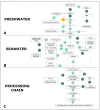Qualitative Risk Assessment for Antimicrobial Resistance among Humans from Salmon Fillet Consumption Due to the High Use of Antibiotics against Bacterial Infections in Farmed Salmon
- PMID: 35625306
- PMCID: PMC9137906
- DOI: 10.3390/antibiotics11050662
Qualitative Risk Assessment for Antimicrobial Resistance among Humans from Salmon Fillet Consumption Due to the High Use of Antibiotics against Bacterial Infections in Farmed Salmon
Abstract
Background: Worldwide, aquaculture is considered as a hotspot environment for antimicrobial resistance (AMR) due to the intense use of antibiotics in its productive systems. Chile is the second largest producer of farmed salmon worldwide, and tons of antibiotics are used to control bacterial diseases, such as Salmon Rickettsial Syndrome (SRS) and Bacterial Kidney Disease (BKD). However, studies determining the risk of consuming salmon fillets that have been treated with antibiotics during the salmon production are limited. Consulting leading experts in the field could provide a knowledge base to identify and address this question and research gaps. Methods: Multisectoral risk perception of AMR through salmon fillet consumption was evaluated by eliciting expert data obtained through discussions during a workshop and from questionnaires given to experts from academia (n = 15, 63%), the public sector (n = 5, 21%), and the salmon industry (n = 4, 17%). Results: The qualitative risk analysis suggested an overall 'low' probability of AMR acquisition by consumption of salmon fillet that had been treated during the production cycle. The risk perception varied slightly between production stages in freshwater and seawater. In consensus with all sectors, this overall 'low', but existing, risk was probably associated with bacterial infections and the use of antibiotics. Conclusions: As it is essential to reduce the use of antibiotics in the Chilean salmon industry, this intersectoral approach and consensual results could favor effective implementation of targeted initiatives for the control and prevention of major bacterial diseases.
Keywords: Chile; aquaculture; food animal production; food safety; qualitative risk analysis; salmon farming.
Conflict of interest statement
The authors declare no conflict of interest.
Figures


Similar articles
-
Current Status of the Use of Antibiotics and the Antimicrobial Resistance in the Chilean Salmon Farms.Front Microbiol. 2018 Jun 18;9:1284. doi: 10.3389/fmicb.2018.01284. eCollection 2018. Front Microbiol. 2018. PMID: 29967597 Free PMC article. Review.
-
Impact of salmon farming in the antibiotic resistance and structure of marine bacterial communities from surface seawater of a northern Patagonian area of Chile.Biol Res. 2024 Nov 10;57(1):84. doi: 10.1186/s40659-024-00556-4. Biol Res. 2024. PMID: 39523335 Free PMC article.
-
Chilean aquaculture and the new challenges: Pathogens, immune response, vaccination and fish diversification.Fish Shellfish Immunol. 2020 Mar;98:52-67. doi: 10.1016/j.fsi.2019.12.093. Epub 2019 Dec 31. Fish Shellfish Immunol. 2020. PMID: 31899356 Review.
-
Antimicrobial resistance in Chilean marine-farmed salmon: Improving food safety through One Health.One Health. 2021 Jan 24;12:100219. doi: 10.1016/j.onehlt.2021.100219. eCollection 2021 Jun. One Health. 2021. PMID: 33553565 Free PMC article. Review.
-
Why Does Piscirickettsia salmonis Break the Immunological Paradigm in Farmed Salmon? Biological Context to Understand the Relative Control of Piscirickettsiosis.Front Immunol. 2022 Mar 21;13:856896. doi: 10.3389/fimmu.2022.856896. eCollection 2022. Front Immunol. 2022. PMID: 35386699 Free PMC article. Review.
Cited by
-
Antibiotics alter development and gene expression in the model cnidarian Nematostella vectensis.PeerJ. 2024 May 20;12:e17349. doi: 10.7717/peerj.17349. eCollection 2024. PeerJ. 2024. PMID: 38784394 Free PMC article.
-
A First Insight into the Microbial and Viral Communities of Comau Fjord-A Unique Human-Impacted Ecosystem in Patagonia (42∘ S).Microorganisms. 2023 Mar 30;11(4):904. doi: 10.3390/microorganisms11040904. Microorganisms. 2023. PMID: 37110327 Free PMC article.
-
Misunderstandings and misinterpretations: Antimicrobial use and resistance in salmon aquaculture.Environ Microbiol Rep. 2023 Aug;15(4):245-253. doi: 10.1111/1758-2229.13147. Epub 2023 Mar 19. Environ Microbiol Rep. 2023. PMID: 36934450 Free PMC article.
-
Towards Sustainable Antibiotic Use in Aquaculture and Antimicrobial Resistance: Participatory Experts' Overview and Recommendations.Antibiotics (Basel). 2024 Sep 14;13(9):887. doi: 10.3390/antibiotics13090887. Antibiotics (Basel). 2024. PMID: 39335060 Free PMC article.
References
-
- FAO . State of World Fisheries and Aquaculture 2020: Sustainability in Action. Food & Agriculture ORG S.L.; Rome, Italy: 2020.
-
- Garlock T., Asche F., Anderson J., Bjørndal T., Kumar G., Lorenzen K., Ropicki A., Smith M.D., Tveterås R. A global blue revolution: Aquaculture growth across regions, species, and countries. Rev. Fish. Sci. Aquac. 2020;28:107–116. doi: 10.1080/23308249.2019.1678111. - DOI
-
- Sernapesca . Informe Sobre Uso de Antimicrobianos En La Salmonicultura Nacional—Año 2020. Servicio Nacional de Pesca y Acuicultura; Santiago, Chile: 2021.
-
- Mardones F.O., Paredes F., Medina M., Tello A., Valdivia V., Ibarra R., Correa J., Gelcich S. Identification of research gaps for highly infectious diseases in aquaculture: The case of the endemic piscirickettsia salmonis in the chilean salmon farming industry. Aquaculture. 2018;482:211–220. doi: 10.1016/j.aquaculture.2017.09.048. - DOI
Grants and funding
LinkOut - more resources
Full Text Sources
Research Materials

